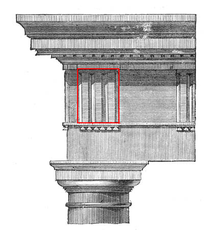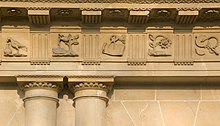Triglyph
[2] In the strict tradition of classical architecture, a set of guttae, the six triangular "pegs" below, always go with a triglyph above (and vice versa), and the pair of features are only found in entablatures of buildings using the Doric order.The triglyph is largely thought to be a tectonic and skeuomorphic representation in stone of the wooden beam ends of the typical primitive hut, as described by Vitruvius and Renaissance writers.The wooden beams were notched in three separate places in order to cast their rough-cut ends mostly in shadow.Of the two groups of 6th-century metopes from Foce del Sele, now in the National Archaeological Museum of Paestum, the earlier uses the first method, the later the second.For example, the Baroque Černín Palace in Prague (1660s) has triglyphs and guttae as ornaments at the top of arches, in a facade using an eclectic Ionic order.

Doric orderTheater of MarcellusJohn WoodThe CircusBath, Somersetmetopesfriezeclassical architectureglyphsguttaeentablaturesTuscan orderskeuomorphicprimitive hutVitruviusRenaissanceGreek architectureRoman architectureTemple of AphaeaFoce del SeleNational Archaeological Museum of PaestumČernín PalacePragueIonic orderTemple of Concordia, AgrigentoTemple of AphaiaHephaisteionFascia (architecture)public domainChisholm, HughEncyclopædia Britannica